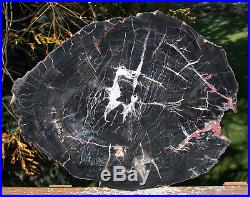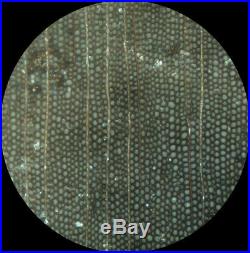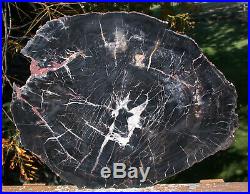




This may be the single most interesting and collectible of all of the magnificent Arizona petrified wood slabs that we’ve ever offered. The high contrast black with with mineral veins is attractive and the shape is very nice, but the real fascination in this piece is the story it has to tell. It comes from an exposure in the vast southwestern US petrified wood deposits from the Chinle Formation dubbed the Black Forest. The name source is somewhat obvious, but less well known is that specimens from the Black Forest were what was first described from the Arizona petrified forests over a century ago that have created one of the better known debates within the scientific community of paleobotanists! I’ll share a bit of that story further into the description, but the short version is that I believe this slab is actually from one of the species that was originally described as. By Knowlton in 1889. That detail alone would make this a nice collector specimen, but it turns out that is just the beginning of the story! Due to a combination of procedural errors and failure to discern distinctions between different species, the name A. Arizonicum is now considered. Nomen superfluum by scientists a problem that gets all the more complicated since it is the legally adopted name of the state fossil of Arizona! Now, through more recent research. The Black Forest logs are called. I believe this particular specimen is. Due to the intercellular spaces you can see in the microphoto, which kind of makes it the closest thing to the original Knowlton. That exists and is a likely candidate for what the Arizona legislature may or may not get around to renaming one day for the state fossil! While the formalized debates are held in hallowed halls, my humble little shop takes pride in knowing this specimen is presented in it’s full glory to tell its story to you and all who study it in the future. The mirror finish coaxed from this slightly less silicified wood extends even to the characteristic mineral veins found in most Chinle specimens. The indent on the side is where a large knot formed in the log. It’s a fascintating and beautiful specimen sure to be a prized member of any collection! But I do enjoy a taste of the scientific side of a hobby that I’m primarily drawn to for the aesthetics. I love the art at least as much as I do the ancient genetic story that each piece represents. But sometimes the scientific story becomes sordid enough to overshadow the art, and this is one of those times! In 1889 Frank Knowlton published a paper describing some black fossil logs recovered from Arizona. He called the species. Two of the three pieces he used were housed in The Smithsonian while a third was lost to time. Scandalously, when the research and specimens were examined more closely (presumably with better microscopes) the three pieces turned out to be different species. As none was ever labeled to be the holotype (single reference specimen) for the new species Knowlton was describing, the pieces became syntypes of equal weight which means you can’t really have A. Arizonicum hanging around in the hallowed halls of academia because, well, the syntypes aren’t actually the same thing! The most comprehensive recent paper that tries to address and clean up the confusion was published by Rodney Savidge in 2007. His paper attempts to explain and re-organize what is known of the now many species that have been identified in this vast forest of giant fossil trunks in the Arizona petrified forest. One of the original three pieces was a Black Forest log that, in an apparent attempt to leave some naming credit with Knowlton, was called. While it is admittedly dangerous to try to identify a conifer based on cross section detail alone, the fact that it comes from the Black Forest combined with the intercellular spaces you see in the most zoomed in microphoto makes it uniquely match this conifer in Savidges summary paper. The paper’s title is something only a real paleobotanist could come up with. “Wood anatomy of Late Triassic trees in Petrified Forest National Park, Arizona, USA, in relation to Araucarioxylon arizonicum Knowlton, 1889″. And you thought Sticks in Stones descriptions were wordy! The paper is easy to find online and provides good reference microphotos. My identifications can never be considered definitive because I’m usually only studying them in cross section. To truly distinguish closely related species it is sometimes necessary to prepare specimens cut from three different directions in the trunk (think of the faces of a cube). While this level of analysis is rarely interesting (or practical) to the hobby collector, the paper does show how it becomes important to distinguish some of these ancient conifers and the confusion that can result when the analysis is spotty in the formal description of a species. I’m relying on a couple of distinguishing features from the specimens Savidge describes to arrive at my conclusion (the black forest location and the intercellular spaces) but you are undoubtedly now armed well enough to begin your own exploration with this fascinating and exquisitely preserved fossil to see if you share the opinion! If you’re new to our shop the one thing you should expect is to see an unexpectedly glossy finish on each stone we prepare. This complete round is a wonderful example of our work. It’s been cut with a diamond saw and flat lapped on equipment I built myself to produce a mirror perfect polish unmatched by any of our many would-be imitators. The detail captured and revealed through the highly polished surface is just immaculate in most wood, slightly less dramatic in this variety. It’s easily some of the most interesting wood to be found anywhere and we’ve prepared it to be all that it can be! It’s a truly special find and we won’t likely have a lot more so get a piece for your collection while it’s available! This is a slab from the center of the log and measures about 13 3/8″ x 10 3/4″ across the polished face and is cut approx 0.52 thick. Weight is about 5 lbs. A nice, unique natural wonder collectible exclusively from Sticks-in-Stones Lapidary! The item “SiS 13+ Chinle BLACK FOREST Petrified Wood Round Arizona Pullisilvaxylon” is in sale since Friday, May 29, 2020. This item is in the category “Collectibles\Rocks, Fossils & Minerals\Fossils\Vegetation\Petrified Wood”. The seller is “rockshop” and is located in Beaverton, Oregon. This item can be shipped worldwide.
